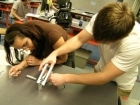By Chris Haigy
If you weren’t lucky enough to get a huge scholarship or to have been born the child of an oil tycoon, there’s a good chance that you’ll be paying for your education, at least partially, with financial aid. For most people, this means loans, which start you out after graduation in debt, or grants, which never seem quite big enough—but there’s another option of which too few students take advantage. Work-study programs, in which students work part-time in on-campus jobs (or selected non-profits), put the money you earn towards your tuition. Generally, these are fairly menial and pay minimum wage (or just slightly better), so they tend to be ignored by students who think they can earn more by waiting tables. But a work-study job might be worth considering.
Unlike your wages from a standard paying job, the money you make from a work-study position is not considered when calculating your financial aid for the upcoming year. Typically, your paycheck hurts your chances of getting aid, up to an upsetting 50 cents on the dollar, but work-study income is free money as far as FAFSA is concerned. Also, there’s usually an option to have your wages paid in the form of a check or applied directed to your tuition (which is a great option if, like me, you have a tendency to blow huge amounts of money on designer beef jerky).
Most people think that a work-study job isn’t going to lead anywhere, and they promptly turn it down. However, there are many tiers of work-study, with varying levels of pay. The experience you gain in a low-level job will help you get the cushier and more fun job that you’re hoping for—which could very well lead to a career. And work-study jobs can translate much more easily to real-world jobs than some students think. For instance, you might be asked to help ESL students write grammatically correct papers, which happens to look great on a resume for an editorial assistant position.
Also, while you could certainly make more money waiting tables (or that holy grail of collegiate jobs, bartending), if you’re going to school in a non-urban setting your off-campus options will probably be pretty limited. Still, no matter where you go to school, work-study jobs usually involve sitting behind a desk, doing some variation of checking IDs at the computer lab. It’s not glamorous by any means, but it’s a perfect opportunity to get paid to do your homework—which will never happen again, trust me. So especially when you’re a freshman still adjusting to a college schedule, a work-study job could be a perfect way to get some cash and still get through the Metaphysics of Morals.
What’s more, there’s almost never a punishment for dropping out of work-study halfway through. Read the fine print carefully (very rarely, some schools penalize students who don’t honor their work-study commitments), but for the most part, even if you think you don’t want the job it can’t hurt to try it out.
So now that you know the reasons to take the job, how do you get it? Well, first fill out your FAFSA form like you would with any other type of financial aid. You’ll automatically be evaluated based on your need, and if you’re eligible you’ll find out how much work-study aid you’ve qualified for. Your assignment (that is, whether you’ll be checking IDs or slinging tater tots in the cafeteria or helping ESL students with grammar) won’t come until a few weeks after you’ve accepted the award.
If your award letter does not indicate that you qualify, but you’re still interested in work-study, contact your financial aid officer. Many schools have non-need-based work-study programs that operate in pretty much in the same way.
